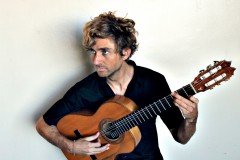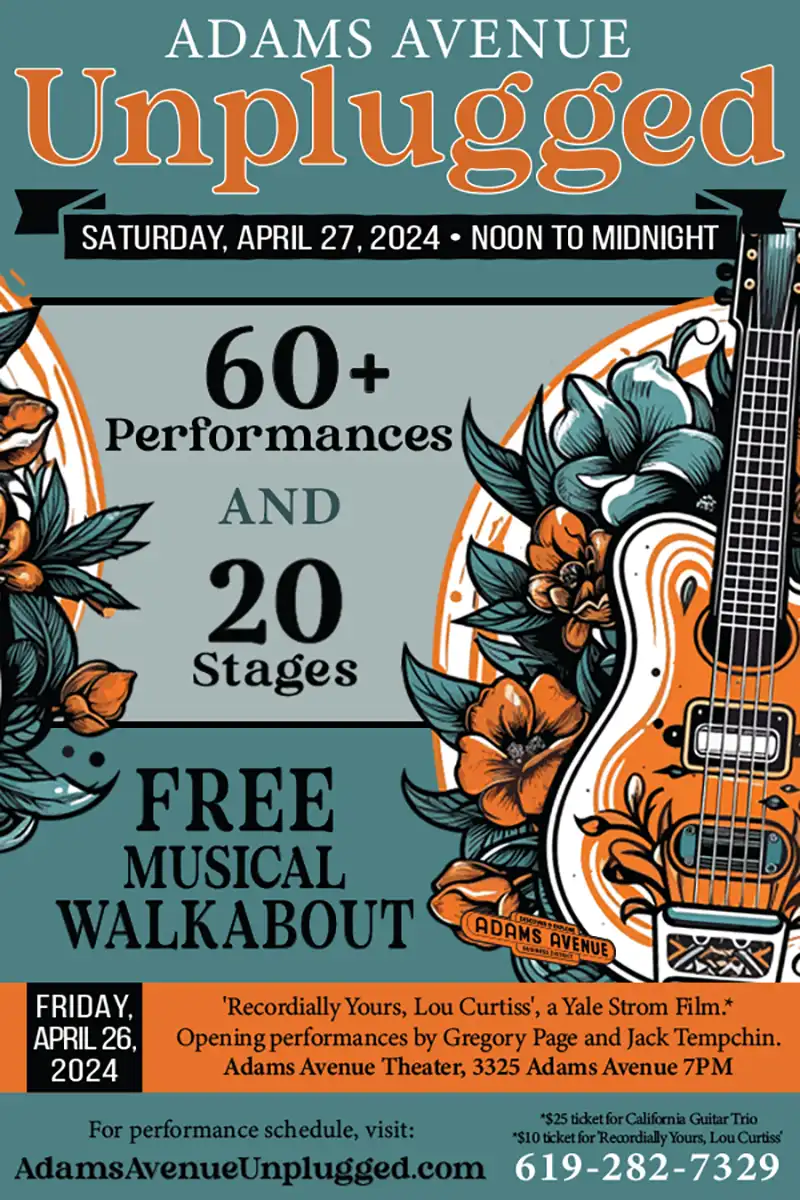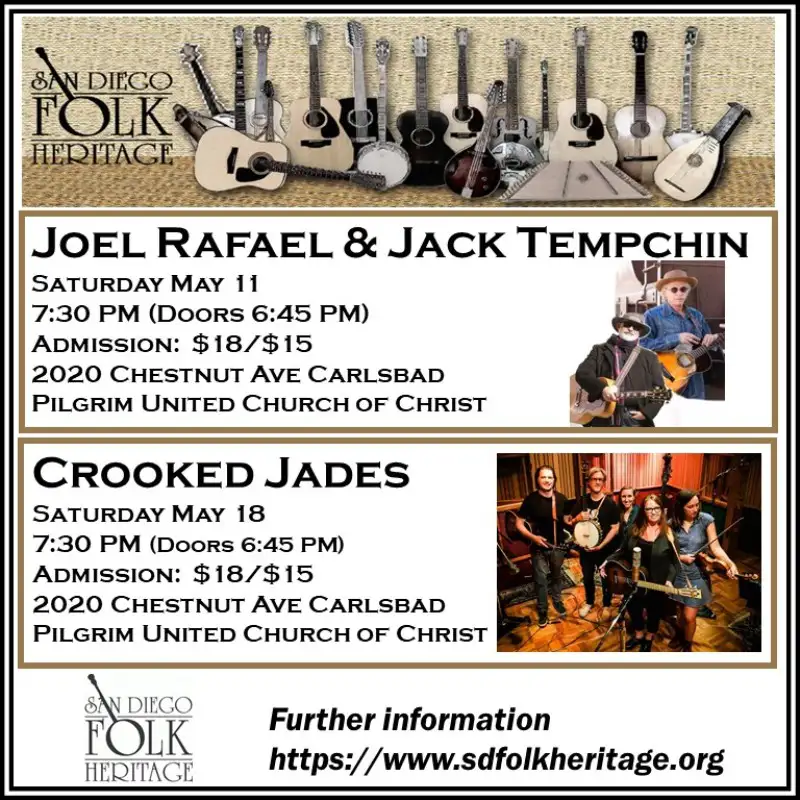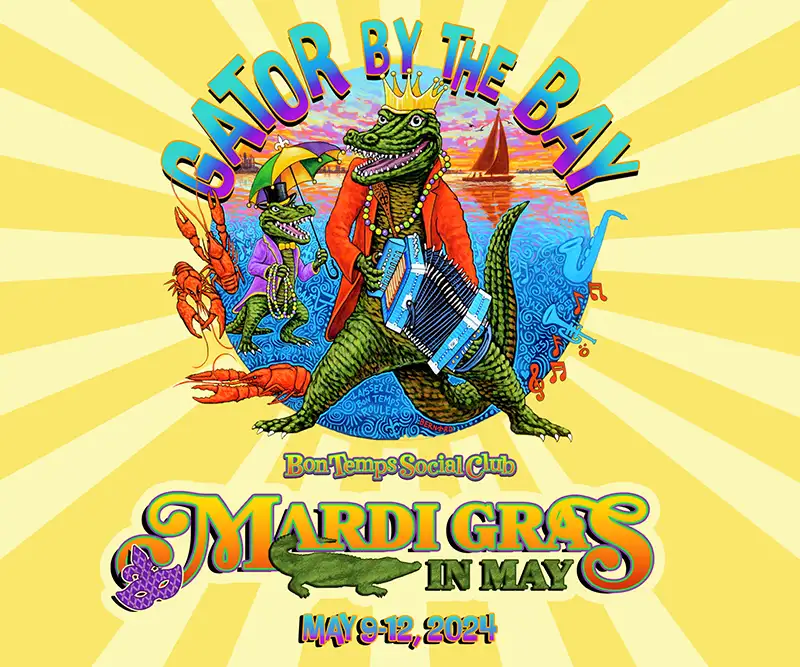Featured Stories
Dusty Brough: New Times for Nylon

Dusty Brough
“This is what I’ve always done,” says Dusty Brough, his blond hair, curly and more than a little wild, pulled more than combed to one side. It’s a warm fall morning, the kind we get here in San Diego when there is a mild Santa Ana. We’re sitting outside, on the deck of the Living Room coffee shop on El Cajon Blvd. “Everything that I’ve worked on suited itself to a nylon-stringed guitar,” he says.
You won’t see Brough with a Telecaster. You won’t see him play a Gibson Les Paul. He does not strum a Martin 12-string. Dusty Brough pumps nylon. He plays classical guitars as well as solid body guitars that, in classical guitar fashion, are strung with nylon strings.
Nylon is the innovation for classical and flamenco guitars so they don’t have to deal with the hassles of gut strings, the organic material that classical guitarists (as well as other stringed instrument players) used until the advent of synthetic polymers in the 1930s. Other than this substitution, those who pump nylon are a conservative bunch. They stick to tried and true compositions, playing standard classical or flamenco repertoire.
Brough breaks this mold. Neither a strict classical or flamenco performer, he blends jazz with Eastern European sensibilities and rhythms (more about this later) and throws in some of the flamenco and classical that folks expect when they see a nylon string guitar. What distinguishes Brough is the seemingly unselfconsciousness of this blending. Musicians have worked at breaking down barriers for generations. Gershwin bridged the gap between classical music and jazz. Miles Davis, Chick Corea, and others broke the barrier between jazz and rock. These have been concerted efforts. For a great deal of the resulting music there is often a forced quality, something a little unnatural about orchestral oboes playing blue notes or jazz trumpeters trying to play the licks of a rock guitarist. You can hear when a jazz facade has been thrown up over a classical structure or the rock ‘n’ roll takes over the jazz in a jazz/rock fusion. As I said, it can sound forced.
For Brough, he doesn’t seem to be dipping or sampling the different musical genres or trying to hammer them together. It’s more like he is stirring them together in a musical cauldron, almost as though the barriers were never there in the first place. I’m left with the impression that he might say, “Musical barriers? What barriers?” To hear Brough play his nylon-stringed guitar, the mixing and amalgamation of flamenco, jazz, and other music is seamless. Jazz harmonies infuse flamenco rhythms and licks, fluidly blending the two as he adroitly executes lines and phrases that give way to chording. Brough could probably keep up his lightening quick playing for long stretches of time, showing off like a lot of guitarists, but he pulls back. He exemplifies a lot of maturity in his playing.
Back to the classical guitarists: Besides being conservative in their choices of music, they are not prone to all the bells and whistles that electric guitar players are so eager to use, the flangers and fuzz boxes that they stomp on during their performances. Brough bucks this trend as well. When he’s playing his solid body nylon, he often uses the same sort of effects boxes that rock and roll guitarists plug their instruments into. “All these effects that I use are mostly made for electric guitars, so when you plug a nylon stringed guitar into one of them it can be interesting. You wind up with sounds that you don’t hear all that often,” he says.
It may have been almost inevitable that Brough became a musician. Growing up in a small berg a stone’s throw from Yosemite National Park, his father played guitar and a friend of his father’s introduced the young Brough to the flamenco guitar. “I was 12 when I first started playing. I wound up fooling around on a nylon string guitar and just kept doing it,” he says. He took classical lessons and played flamenco, although he did wind up playing some rock and punk, jamming with his friends in his early teens.
Like dozens, perhaps hundreds of other transplants to extreme Southern California, Brough moved to San Diego with a band. He had been playing with a flamenco band, Cerro Negro, and the entire band moved here in 2001. Though the members have gone their separate ways since, the band still performs, mostly in California and Hawaii.
Brough performs with the Hot Blood Orkestar, an eight-piece ensemble. “What we play is basically Balkan music with drums and electric bass,” he says. “Some of what we play is traditional Balkan music, and we play some material that we’ve written.” The band has been together and performing for the last three or four years and has just released their first CD (reviewed in this issue). Brough credits his roommate Ryan Feldthouse as being the driving force behind the band. Feldthouse plays violin, bouzouki, and the darbuka, a type of Middle Eastern drum. Another roommate, drummer Julien Cantelm, is also a member of the ensemble. Brough says, “This type of music is interesting, unlike a jazz band, where the drums and bass are the center of the rhythm, it’s the melodies that dictate the rhythm and where the tune is going to go. Because of that, sometimes you can wind up with these bigger longer grooves.”
Cantelm and Brough perform as a duo. The pairing of the guitar with drums, and only guitar and drums, can be a dicey proposition. Though the guitar is a baritone instrument, there is a lot of bottom — what the piano player’s left hand can do with chords and bass lines — that is missing.
Without that bottom end, it can seem like there is nothing connecting the drums and guitar, almost as though there are two musicians playing independently of each other.
Brough and Cantelm avoid these musical pitfalls, blending the two instruments and communicating between the two instruments as few have done. Drums can overpower almost any other instrument, particularly the guitar, but Cantelm plays with a great deal of sensitivity. The two further test the outer limits of the capabilities of a drum guitar pairing by playing in odd meters, the ones that are at least odd to most American ears such as 5/4, 7/4, and 11/4.
And if all these musical projects weren’t enough, Brough stays busy by performing in other duos and trios. He performs often with Natasha Kozaily, a recent transplant to San Diego. With a light voice that might be compared to Kate Bush, Kozaily blends her background in classical music with her Caribbean upbringing and Middle Eastern heritage for a sound that is sometimes quirky, often ethereal, and always quite delightful. Another project for Brough is a duo with San Diego-based tabla performer Miles Shrewsbery. Calling themselves Therianthrope, they perform as wide a range of music that a guitar and tabla can get their arms around. Brough says, “Miles and I wind up doing a mix of things. It could mostly be described as music based on odd rhythms, which is Balkan music combined with western theory and harmony. Some of our compositions are generated by us just getting together and working out things.”
Last month noted a number of releases for Brough. He released a solo CD, Tortoise in the Presence of a Goldfish on Veterans’ Day, which draws on all his experience in flamenco, jazz, Latin, and Balkan music. Hot Blood Orkestar released their premier CD. And on the fifth of this month Therianthrope, the duo of Brough and tabla performer Shrewsbery, will have a release for their digital EP at UCSD’s Loft. Both Brough’s CD and the Therianthrope EP are on Avaaz Records, a record company that Shrewsbery recently got off the ground.
Early last month Hot Blood Orkestar capped off their California tour and celebrated the release of their first CD with a performance at the Gaslamp’s La Gran Tapa. As the band readied itself for their performance, the restaurant was still filled with a dinner crowd. The patrons were pretty subdued and fairly mixed in age groups. An older couple sits in the corner. She looks like Jean Stapleton in her role as Edith Bunker. With maroon and tones of ochre accentuating the woodwork and plaster of La Gran Tapa’s interior, this longstanding bastion of downtown San Diego’s nightlife exudes ambiance in spades. It’s past Halloween, but some of the waiters and waitresses are ghouls or skeletons. My waiter is a cross between a zombie and the mad hatter. I admire his red bow tie.
To one side is a drum set, a bouzouki, a violin, a tuba, an electric bass, and guitar. And amplifiers. Some of the band members are wearing Halloween costumes. Dusty Brough is a devil and Ryan Feldthouse wears a fez and rust-colored pantaloons.
Hot Blood Orkestar begins with a fast one, one of their odd metered compositions. The sax and violin play in unison fast, really fast lines punctuating with stops; then we get a slow modal and very expressive solo from the sax. There is more than a hint of the freygish scale, but there are some other things at play here. These guys, all of them American born and raised, have done their homework, firmly establishing a Balkan vibe but not even coming close to sounding like an Ali Babba movie soundtrack.
Kevin Hill, the bassist, does what he continues to do throughout the evening, laying down his electric bass and picking up a tuba. The sound of his bass is thick and solid, what you would expect from a bass player in a rock band. Amplified, the tuba has a similar strong, full presence in the ensemble. This second tune offers a sense of Greek influence. While we’re on the subject of the bass, let’s talk about the drums. Although the bass gives a sort of rock vibe, Cantelm has a lighter approach, more of a jazz feel, to his playing. He is less of a timekeeper, like Charlie Watts, and more of what you’d expect from Philly Joe Jones, hitting the accents and rolls.
Dressed in the flowing garb, a belly dancer joins the extravaganza as the band slows things down. Pretty, with long brown hair, she slinks barefoot in front of the musicians. She directs her seductive poses toward the saxophone as he solos, then winds up within the arms of the violinist as he both bows his violin and embraces her while she continues her dance. It’s all sexy and a great deal of fun.
The pairing of the bouzouki and saxophone is interesting, the bright, bell-like timbres of the bouzouki contrast with the sax. Although the violin is a stringed instrument and the saxophone a reed instrument, their timbres are very similar. And the amplification brings the volume level of both instruments at about the same level, so the overall effect, as the two instruments play in unison, is something of a section playing.
Most of the tunes have been in odd meters. Not growing up in Croatia, I’m no expert, but a few of them sound like they are in 9/4, the same meter that Dave Brubeck used in the head of “Blue Rondo a la Turk.” You’d think that it would resolve down to a ¾ waltz thing, but it never really does. Now the band launches into a tune in 11/4. Wow. Spare and based on a two-note riff that marks out the eleven beats, this tune has a more contemporary sound, with some jazz chords forming the backbone of the harmony. Brough whales away on the tune, as does Paul Bertin on the sax.
The crowd has shifted from a dinner crowd to one of a night life scene. It seems as though everybody in the room is captured by the band. Some folks at the bar say they feel like they are being transported to another land or culture, in the East or Mediterranean. Meniynka Kiravell, a singer/songwriter and San Diego transplant from Detroit, believes that the members of the Hot Blood Orkestar are some of the most brilliant musicians in southern California. She says, “I feel like I’m carried away to another, more exotic world where East meets West.” This group could have easily wound up with a farrago of Eastern and Western music, instead they have created a whole, something inspired, refreshing, and new. The music is at once familiar and exotic, a bit of a challenge for my ears but still accessible.
Hot Blood Orkestar plays in 4/4. I can feel it in my feet, that inherent strong tap of the toe on a familiar and simple beat. Hill returns to the tuba. It’s a tuba but it still has a strong rock feel. The area in front of the band fills with dancers. I’m taking some notes on the concert when Kiravell turns to me and asks, “Wanna dance?”
How could I refuse?
Hot Blood Orkestar CD is reviewed this month.







